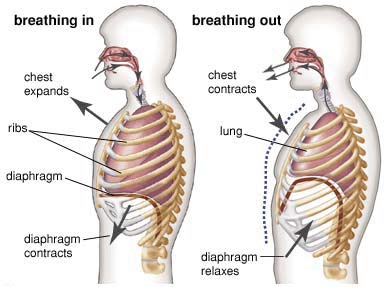breath control

Breathing in and out.
Air is crucial to voice production. It is the flow of air through the various constrictions in the vocal tract that generates sound, and air is also the medium which transmits that sound to our ears. The ability to skillfully control the pressure and flow of air is a large part of successful voice use; new singing students often spend several lessons on proper breath control before doing any serious work on the voice itself. There are several rather specialized breath-related skills that serious singers must develop. With extended training, vocalists can improve their lung capacity, learn to take a larger breath while taking less time to do it, learn to take a 'silent' breath, and keep a steady airflow going to their vocal folds without generating any excess tension in the upper body or neck area.
Each of these skills is essential to good singing, and those who use their voices for speaking – actors, lawyers, sales personnel, etc. - can also benefit from improved breath control. Speech-language pathologists who work with voice patients may find it helpful to learn more about the training of singers and actors. The breath control skills used for performers' voices may also be used with persons with voice disorders to facilitate healing of tissue or overcoming a disorder.
Flow and pressure
The airflow necessary for singing or speaking is generated by pressure exerted on the lungs by the diaphragm and abdominal muscles. This flow is measured in cubic meters of air passing a given point per second (m3/s). Pressure is measured in pascals (Pa); a pascal is defined as a pressure of one newton per square meter (N/m2). Since one pascal is a small amount of pressure, the kilopascal (1,000 pascals; the symbol is kPa) tends to be used for pressures relevant to voice use. A kilopascal is approximately equal to the weight of an apple distributed over a 10 cm2 surface (around half the size of a credit card).
Pascal's law
The pascal is named for the French scientist and philosopher Blaise Pascal, who discovered a principle now known as Pascal's law: pressure is transmitted rapidly and uniformly throughout an enclosed fluid at rest. So, for instance, if we contract our lower abdominal muscles with our glottis closed, the pressure in the lower part of our lungs is increased, and this change is quickly transmitted to the rest of our lungs. If the glottis is then opened, air will then rush out until the lung pressure is equal to the pressure of the surrounding air.
Alveolar (lung) pressure
The lungs are composed of millions of tiny alveoli, or air sacs. These sacs are connected by a network of ducts, beginning with the trachea, then separating into smaller and smaller tubes in each lung, called bronchioli. Pascal's law dictates that the pressure in each of these millions of tiny sacs is the same, and it is called the alveolar pressure.
An instrument called a U-tube manometer can be used for measuring the maximum lung pressures a person can generate; the instrument consists of a U-shaped tube partially filled with liquid. The test subject blows into one end of the tube, and the amount of liquid displaced is measured to determine the pressure. This is not a particularly useful test for voice research, however, since the U-tube manometer closes off the airway during the test. During singing and speech, the airway remains open, and directly measuring lung pressure accurately while keeping the airway open can be difficult.
Lung pressure can be indirectly measured, however, by placing a pressure transducer between a subject's lips and having the subject say a word that begins with 'p'. A measurement would be taken while the lips are closed and just before they burst open with the 'p'. Pascal's law tells us that the pressure in the mouth must be the same as that of the alveoli.
Lung volume
The total volume of air that an average adult can hold in his/her lungs is around 6–7 liters. However, only part of this air can actually be used; around 2 liters of that is always present in the lungs, and is called residual volume. This air can't be expelled unless the lungs collapse.
The remaining volume of 4–5 liters, the tidal volume, is usable for respiration or voice use. However, we rarely use all of this capacity; at rest, we may only breathe in and out around 10–15% of the tidal volume. The rest is held in reserve for more demanding physical activities, such as exercise or singing, which can demand our entire tidal volume.
Boyle's law
This law, named for the British scientist Robert Boyle, states that, in a soft-walled enclosure at constant temperature, pressure and volume are inversely related. Increasing volume causes a proportional decrease in pressure, and vice versa. Boyle's law explains why the lung pressure decreases when we increase the volume of our lungs by expanding the rib cage and contracting the diaphragm to inhale. Conversely, when we exhale, the rib cage contracts and the diaphragm relaxes into its more curved position, thus decreasing the lung volume and causing pressure to rise. This pressure then causes air to rush out of the lungs.
Muscle use in breathing
The cycle of breathing can be divided into four discrete phases of muscular effort:


